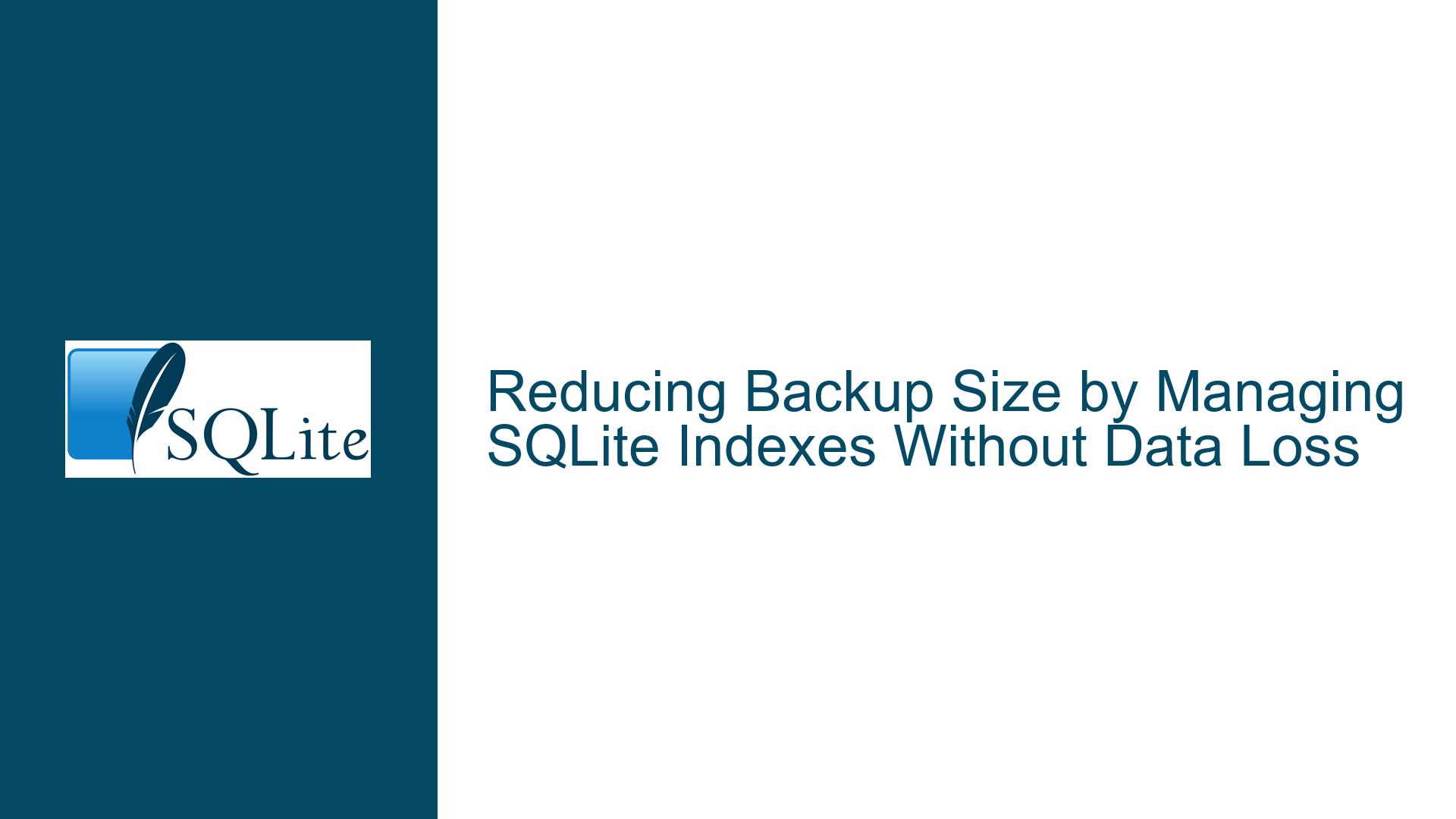Reducing Backup Size by Managing SQLite Indexes Without Data Loss
Understanding the Need to Preserve Index Definitions While Excluding Data
The core challenge revolves around minimizing the size of SQLite database backups by excluding index data while retaining the index definitions (schema). This allows the backup file to occupy less storage space, with the expectation that indexes will be rebuilt during the restore process. However, SQLite does not provide a direct mechanism to "empty" an index of its data without dropping the index entirely. The absence of a native TRUNCATE INDEX command or similar functionality forces users to explore workarounds that involve schema manipulation, data deletion, or external backup optimization techniques.
Indexes in SQLite are stored as separate B-tree structures within the database file. Each index consumes disk space proportional to the number of indexed rows and the size of the indexed columns. When a backup is performed (e.g., using .dump, VACUUM INTO, or file copying), the entire database file—including all index data—is included. For large databases, indexes can constitute a significant portion of the backup size. The desire to exclude index data stems from the observation that indexes can be regenerated from the underlying table data during restoration, provided their definitions (the CREATE INDEX statements) are preserved.
This problem intersects with SQLite’s transactional guarantees, storage architecture, and backup/restore workflows. Any solution must ensure that:
- The original table data remains intact and queryable.
- Index definitions are retained in the backup.
- The backup process does not introduce data corruption or schema inconsistencies.
Factors Leading to Large Backup Sizes and Index Management Constraints
1. Index Storage Overhead in SQLite
SQLite stores indexes as separate B-trees, which are optimized for read operations but contribute directly to the database file size. Each entry in an index includes the indexed column values and a reference to the corresponding row in the table. For example, an index on a users(email) column will store every email value and a rowid or primary key reference. In datasets with high cardinality or wide columns, this overhead becomes substantial.
2. Absence of Native Index Truncation or Data Removal
Unlike tables, which support DELETE or TRUNCATE operations to remove data while preserving structure, indexes lack equivalent functionality. The DROP INDEX command is the only way to eliminate index data, but it also removes the index definition from the schema. This creates a catch-22: dropping indexes reduces backup size but requires re-creating them later, which complicates restoration.
3. Backup Compression Limitations
While compressing backup files (e.g., using gzip, 7zip, or Zstandard) can reduce storage requirements, it does not address the fundamental issue of index data redundancy. Compressed backups still include index data, and the compression ratio depends on the entropy of the data. Indexes, which often contain sorted or repetitive values, may compress well, but this varies by use case.
4. Transactional Integrity During Backup
SQLite’s VACUUM command rebuilds the database file, repacking data and freeing unused space. However, VACUUM requires exclusive access to the database and can be time-consuming for large datasets. If indexes are dropped before vacuuming, the process will omit their data from the new file, but this requires careful coordination to ensure indexes are re-created correctly.
5. Application and Query Performance Trade-offs
Dropping indexes before a backup may temporarily improve backup speed and reduce size, but it degrades query performance until indexes are rebuilt. Applications relying on indexes for WHERE, JOIN, or ORDER BY clauses will experience slowdowns during the restoration phase.
Strategies for Minimizing Backup Size via Index Management
1. Index Definition Extraction and Conditional Dropping
The safest approach involves programmatically extracting index definitions, dropping indexes before backup, and re-creating them during restoration. This method leverages SQLite’s sqlite_schema (formerly sqlite_master) table to capture CREATE INDEX statements.
Steps:
Extract Index Definitions:
CREATE TABLE index_backup AS SELECT name, sql FROM sqlite_schema WHERE type = 'index' AND sql IS NOT NULL;This creates a temporary table storing index names and their SQL definitions.
Drop Indexes:
Use a script (e.g., Python, shell) to iterate over theindex_backuptable and executeDROP INDEXstatements:import sqlite3 conn = sqlite3.connect('database.db') cursor = conn.cursor() cursor.execute("SELECT name FROM index_backup") indexes = cursor.fetchall() for index in indexes: cursor.execute(f"DROP INDEX IF EXISTS {index[0]}") conn.commit()Perform Backup with
VACUUM INTO:VACUUM INTO 'backup.db';This creates a minimized backup file without index data.
Restore and Rebuild Indexes:
After restoringbackup.db, re-create indexes using the stored definitions:cursor.execute("SELECT name, sql FROM index_backup") indexes = cursor.fetchall() for name, sql in indexes: cursor.execute(sql) conn.commit()
Advantages:
- Guarantees index definitions are preserved.
- Uses standard SQLite commands, minimizing risk.
Risks:
- Applications may experience downtime during index dropping/rebuilding.
- Requires careful error handling to avoid orphaned indexes.
2. Schema Manipulation with Dummy Tables
A more advanced (and risky) technique involves modifying the schema to "redirect" indexes to a dummy table, forcing SQLite to rebuild them against the real table during restoration.
Steps:
Create a Dummy Table:
CREATE TABLE dummy (id INTEGER);Alter Index Definitions to Reference the Dummy Table:
Manually update thesqlite_schematable to change the table name in index definitions. For example, change:CREATE INDEX idx_users_email ON users(email);to:
CREATE INDEX idx_users_email ON dummy(email);Warning: Directly modifying
sqlite_schemais unsupported and can corrupt the database. UsePRAGMA writable_schema = 1;with extreme caution.Rebuild Indexes and Vacuum:
REINDEX; VACUUM;This rebuilds indexes against the dummy table (which contains no data), effectively emptying them.
Restore Original Schema:
After backup, revert the schema changes and rebuild indexes against the real table:UPDATE sqlite_schema SET sql = REPLACE(sql, 'dummy', 'users') WHERE type = 'index'; REINDEX;
Advantages:
- Avoids dropping indexes entirely.
Risks:
- High risk of database corruption if schema edits are incorrect.
- Requires deep understanding of SQLite internals.
3. Leveraging Backup Compression and Incremental Strategies
If index management proves too disruptive, consider optimizing the backup process itself:
Use High-Efficiency Compression:
Tools likezstdorxzoffer better compression ratios than traditional algorithms. For example:sqlite3 database.db ".backup backup.db" zstd --ultra -22 backup.dbIncremental Backups with
SQLITE_FCNTL_CKPT_START:
Use SQLite’s incremental backup API to transfer only modified pages between backups. This reduces the size of each incremental backup without altering indexes.Offload Index Regeneration to Restore Scripts:
Combine full backups (with indexes) with periodic index-less backups. During restoration, prioritize critical data and defer index rebuilding to background processes.
4. Validation and Testing Procedures
Regardless of the chosen strategy, validate backups rigorously:
Checksum Verification:
UsePRAGMA integrity_check;andPRAGMA quick_check;to ensure the backup file is not corrupted.Query Performance Benchmarking:
After restoring and rebuilding indexes, run EXPLAIN QUERY PLAN to verify indexes are being used:EXPLAIN QUERY PLAN SELECT * FROM users WHERE email = '[email protected]';Automated Regression Testing:
Implement unit tests that compare query results before and after backup/restore cycles.
5. Alternative Approaches for Specific Workloads
In-Memory Databases for Temporary Data:
For transient data, store tables in an in-memory database (:memory:) or temporary tables, which are excluded from persistent backups.Partial Indexes:
If certain indexes are only needed for archival purposes, redefine them as partial indexes covering a subset of rows.
Final Recommendations and Risk Mitigation
Prefer Index Dropping/Rebuilding Over Schema Hacks:
TheCREATE TABLE index_backupmethod is safer and more maintainable than direct schema edits.Monitor Backup and Restore Performance:
Profile the time and space savings from excluding indexes versus the cost of rebuilding them. Use metrics to justify the approach.Document the Process:
Maintain runbooks detailing backup/restore procedures, including scripts for dropping and re-creating indexes.Consider Hybrid Approaches:
For mission-critical applications, maintain a primary backup with indexes and a secondary compressed backup without them.
By systematically evaluating trade-offs and rigorously testing procedures, organizations can achieve significant reductions in backup size while maintaining data integrity and operational continuity.






